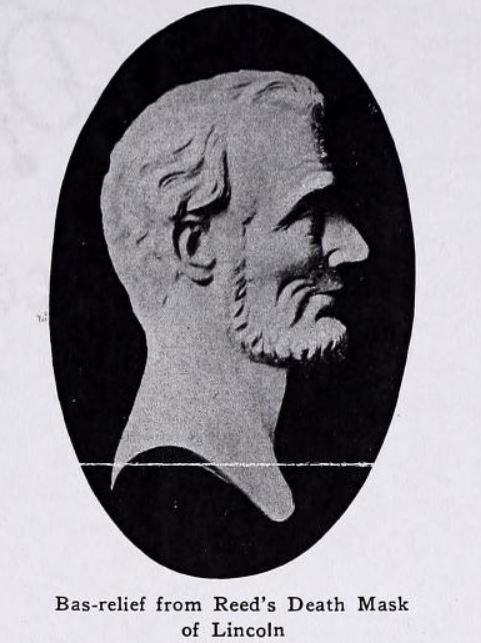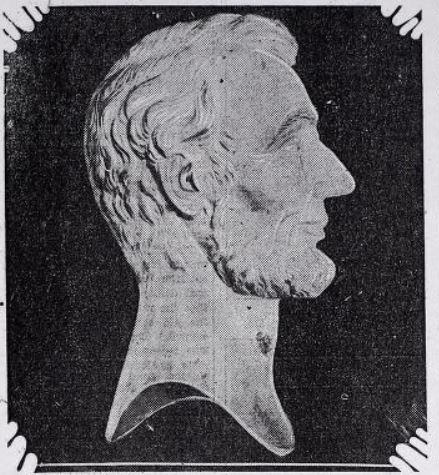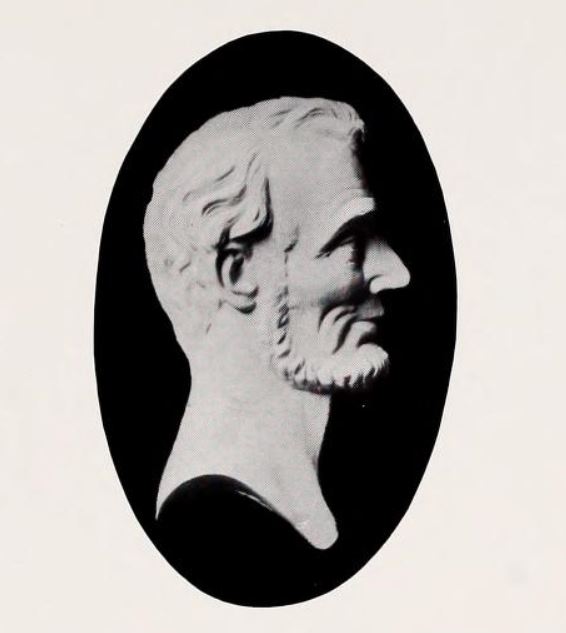Lincoln’s Haunted Death Mask

Lincoln’s Haunted Death Mask Relief said to have been modeled from Lincoln’s death mask.
Break out the wholesome snacks and mats for story-time and announce it in a whisper: It’s National Library Week! It is also the week of Lincoln’s assassination, and it is a very good week when I can combine a purported Lincoln death mask and a haunted library.
STATE LIBRARY MYSTERY MOVING PICTURES CAUSE TALK OF GHOSTS
The Librarian First Said It Was Draughts, but Changed His Mind.
Is the State Library haunted? That is the question that is bothering W. E. Henry, State librarian. Mr. Henry does not believe in “hants.” In fact, he is extraordinarily skeptical about all kinds of superstitions, but recent occurrences in the library rooms have, as the slang expression goes, “got him guessing.” The young women attendants in the library have become alarmed, and are all working close together in the main reading room. Librarian Henry, when sought today, was also found in the main room, apparently busily engaged over some records. He tells the story of the queer occurrences, and his words are substantiated by the young women. The story is something like this:
One day last week, while working alone in the private office of the librarian, Miss Springer, one of the assistant librarians, noticed a peculiar movement about the oval-framed picture of George Washington. At first she paid little attention to it, but her curiosity compelled her to keep observing the picture, and before long she believed she saw it rocking from one side to the other. The librarian was called in, and promptly declared that it was the draught that caused the oval frame to rock. Thus the matter was dropped.
This forenoon the “hants” broke loose with renewed vigor. While the young women were working in the main room a muffled noise was heard in the librarian’s room, and they drew straws to see which one would go to the room. The lot fell to Miss Springer, who, accompanied by Miss Chapin, first assistant librarian, went to the room and found a mirror that had hung by the north window casement lying on the floor many feet from where it had been hanging.
No Draught Apparent.
Mr. Henry was called and again ascribed the occurrence to the draught, but no draught was apparent, and the young woman lost faith in his declarations. On their return to the main room they moved their desks closer together. To add to their concern, they found that the fall had broken a corner out of the mirror, which, certainly, meant “seven years’ bad luck.” [Mirrors or pictures falling off the wall were also omens of death.] At this discovery, one of the young women threatened to submit her resignation.
An hour later Miss Chapin, who faced the row of Governors’’ portraits which hang on the north library wall, suddenly stopped work and pointed to the oil painting of Governor Claude Matthews. The painting was moving slowly but surely, and the canvass on which the features of the Democratic Governor were painted, was vacillating backward and forward. The movement soon stopped and the librarian was again sought. He did not believe the picture had moved, but just as the young women were explaining the occurrence the frame began to move again slowly and ponderously. The picture can scarcely be lifted by one man. Then the librarian gave in. He admitted that he knew of no cause for the motion of the picture. He started to spring the draught theory, but the young women would not hear it, and he admitted that he did not believe a draught could move the picture.
An observer might be induced to believe that no draught could touch Governor Matthews’ picture.
While looking for evidences of other strange occurrences the librarian discovered that the frame containing a death mask of Abraham Lincoln had slipped down and hung at an angle, making the resemblance to the dead face of the martyred President more apparent.
Mr. Henry said to-day: “The things that have happened are truly strange. I don’t believe they have been of supernatural causes, but some of them can not be explained, it seems in any other way.”
The Indianapolis [IN] News 16 July 1900: p. 9
I have to say, the swaying pictures and noises don’t sound all that spooky, but perhaps you had to be there. Indianapolis borders on some of the state’s gas fields; weird manifestations seem to hover around gas and oil territories like a miasma. Perhaps it was something as simple as the building settling. Despite the unimpressive “hants,” what brought me up short was the mention of the “death mask of Abraham Lincoln.”
According to conventional wisdom, there are no death masks of the murdered president. Two masks were made during Lincoln’s life, including one by Clark Mills in February, 1865.
It looks so gaunt and haggard it is often referred to as a death mask….Some Lincoln authorities have claimed that another death mask of Lincoln was made while the body was lying in state in the Capitol at Washington, and other traditions recall one taken at Springfield after the arrival of the body. Evidence is not at hand to confirm either of these statements.
Lincoln Lore 14 December 1931: p. 1
The popular press reported on at least two artists who were said to have made death masks of Lincoln:
Joseph Palmer, the oldest employe of the National Museum and who made the death mask of President Lincoln that has been used in most of the portraits of the martyred President, died yesterday at his home in Rosslyn, Va., near here.
Patriot [Harrisburg, PA] 21 April 1913: p. 2
and young Louis Henri Reed of Indianapolis. The owner, Dr. W.B. Clarke, told of how Reed came to create the image:
REED’S BAS-RELIEF OF LINCOLN’S DEATH MASK
Was Mask made While He Lay in State in City?
WORK OF A YOUNG ARTIST
“The sudden death of artist Louis H. Reed, son of the veteran editor Enos B. Reed, after years of illness, and the death of his aged mother was pathetic,” said Dr. W.B. Clarke. “As the News truly said, ‘During his early education as an artist he gave promise of achieving fame.’…
“One of Henri’s (for that is the way he liked to see his name) early works, if not his best, was a plaster bas-relief of Abraham Lincoln, claimed by some to have been made from a death mask taken from the martyred President’s face as he lay in state at the old capitol here by special permission of Governor Morton. Colonel Holloway, the Governor’s secretary, probably is the one person best qualified to affirm or deny that claim.
“But ‘art,’ at the time this was made, did not get the newspaper booming it now would receive. Would the copy from the death mask of a President nowadays real or reputed, escape newspaper exploitation?
Two or Three Copies Made.
“There were only two, or, perhaps, three, copies of this made. One of these, because of oversight somewhere, I was fortunate enough to procure twenty years ago in a Washington street auction house, said at the time to be part of the effects of Mr. Wallace then sold. Its fidelity as a likeness was certainly equal to any shown of the same subject at the recent Saint Gaudens exhibit here.
“This bas-relief, or, more properly, haute relief of the head and neck of Mr. Lincoln was in full side view, the whole oval being 26 by 21 inches, the head and neck twenty inches long. During the national encampment of the G.A.R. here, in 1893, I hung it from my office window, appropriately draped, with the words, ‘Your Great Commander,’ under it on a large printed placard. This attracted universal attention as the great parade went by, and soon many veterans came up the stairs to obtain a closer view of it. The next day the Indianapolis Journal, of September 3, 1893, made this reference to the decoration.
“’A decoration that would be very difficult to duplicate, as there are but two or three in existence, may be seen on the outer wall of Dr. W.B. Clarke’s office, on Illinois street, opposite the Bates house, and it is one of great historical interest. It is a bas-relief of Abraham Lincoln, the martyred commander-in-chief of all the veterans that are here assembled, and was made from the cast taken from the features of the distinguished dead as he lay in state in this city at the statehouse during the memorable and impressive trip to the tomb.’
Inquiries and Offers
“Kate Field’s Washington of March 28, 1894, also contained a description of the work. As a result of these and other publications I have received inquiries from all over the country, requests for photographs of the bas-relief, offers of purchase, etc., the last only recently from the Oldroyd Lincoln memorial collection, where are exhibited over three thousand articles pertaining to Lincoln in the house in which he died, 516 Tenth street, Washington.
“The only replica of this work I know of was held by Ben L. Darrow, the Meridian street shoe man, living in Illinois street, which Mrs. Darrow told me was a present from Mr. Reed, but, as that family is broken up by death, it would be difficult to locate it, unless the son, Philo, of Chicago, has it. Their copy was the prettier, as mine was unframed, while theirs they had put in a deep wooden frame and covered with glass.
“The fate of mine was as tragic as those of its maker and subject. One night we were awakened by a tremendous rash, and found that the heavy mass had broken the cord that held it high on the wall, and the work of art was smashed to smithereens and beyond the hope of repair.”
Copied from The Indianapolis News April 8, 1910,
There is an intriguing little book that provides sources relating to the Reed “death mask.” It is called Statues of Abraham Lincoln, Louis H. Reed, Excerpts from newspapers and other sources from the files of the Lincoln Financial Foundation Collection, 1930 and it may be found at this link.
Among the items in this booklet are the illustrations in this post and the following notes:
Journalist Nellie G. Owens, writing on 2 April 1935, mentions the death mask and says “I have learned since I found this cast that there is another in existence, The State Library has one, and some organization here has the other.”
And
The following paragraph is copied from Mrs. H.B. Burnet’s “Art and Artists of Indiana” page 68. “When the body of the martyred President Abraham Lincoln lay in state in the Indiana Capitol building, in April, 1865, a death-mask was made by Louis Henri Reed. He was a nephew of B.K. Foster, who was at that time State Librarian and custodian, and through whom the privilege was obtained. From this death-mask was made a medallion in bas-relief, which is an excellent likeness of the great President.”
I called up Mrs. Burnet and asked her where she got her information, and she said that she had all her original notes yet and would look it up some time. I have found her book quite accurate and I think she has been quite sure of her information before she put it in print, so I am inclined to think that her information concerning this bas-relief is accurate.
I could not see that Mrs. Burnet had provided any other document in the booklet that actually proved that such a death mask had been made. And the illustrations muddle the question even further. A death mask is just that—a 3-D mask. Why, if a death mask existed, would you make a bas- (or an haut-) relief out of it? Why would you not make dozens of copies whose authenticity could be argued over by scholars as in the case of Shakespeare and Napoleon? Very short-sighted…
Then there is the puzzling fact that two of the bas-reliefs pictured seem to be identical; while the third is more realistic and more “Lincoln-esque.” The first two seem to my critical eye to resemble James Gregory, who played Senator John Yerkes Iselin in The Manchurian Candidate.

Lincoln’s Haunted Death Mask Another version of the Louis Reed bas relief said to have been taken from Lincoln’s death mask.

Lincoln’s Haunted Death Mask A bas relief said to have been taken from Lincoln’s death mask.
A life-long invalid, Reed was a precocious, self-taught artist. He was born c. 1846, so he was perhaps 19 when/if he modeled Lincoln’s image. In a 1901 article about Reed, the expression “death mask” is not used. The article does say that Reed made the bas-relief “shortly after” Lincoln was assassinated and that he sent a copy of it to General Grant. Perhaps he really did have access to Lincoln’s body and sketched or modeled a profile, only to have it termed a “death mask” after the fact.
When I asked about the object a few years ago, the staff at the Indiana State Library did not know anything about the “death mask.” I can’t tell from searching their collections if it still exists. But apparently other ghosts, perhaps of former librarians, have risen to fill the gap, as in this story about a meet-and-greet with the ghosts of the ISL.
Any ideas about whether the bas-relief still exists or what might have been going on at the Library? The young lady staffers might suggest simple polt activity. Or pranks with strings to get the boss guessing.
chriswoodyard8 AT gmail.com.
Chris Woodyard is the author of A is for Arsenic: An ABC of Victorian Death, The Victorian Book of the Dead, The Ghost Wore Black, The Headless Horror, The Face in the Window, and the 7-volume Haunted Ohio series. She is also the chronicler of the adventures of that amiable murderess Mrs Daffodil in A Spot of Bother: Four Macabre Tales. The books are available in paperback and for Kindle. Indexes and fact sheets for all of these books may be found by searching hauntedohiobooks.com. Join her on FB at Haunted Ohio by Chris Woodyard or The Victorian Book of the Dead.
